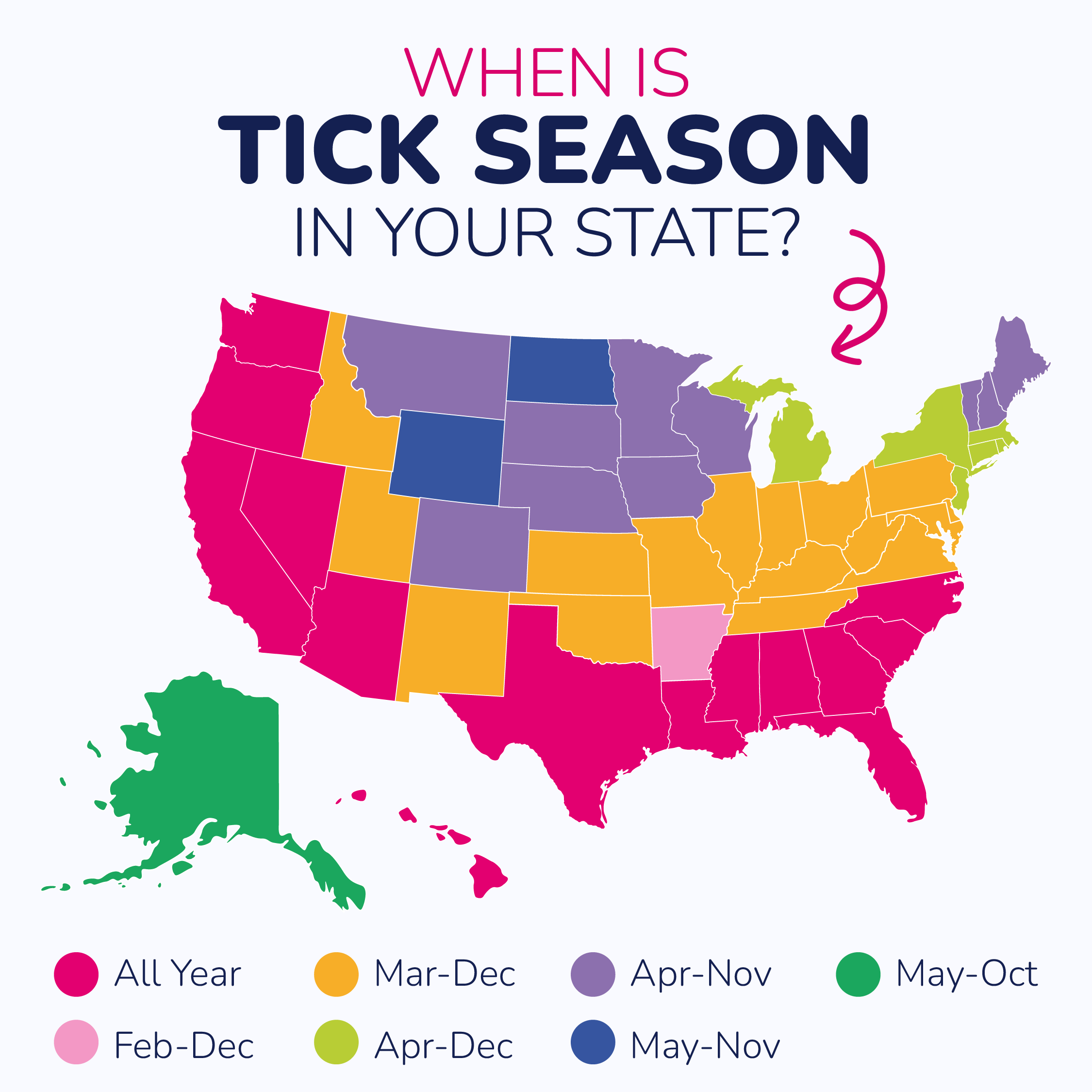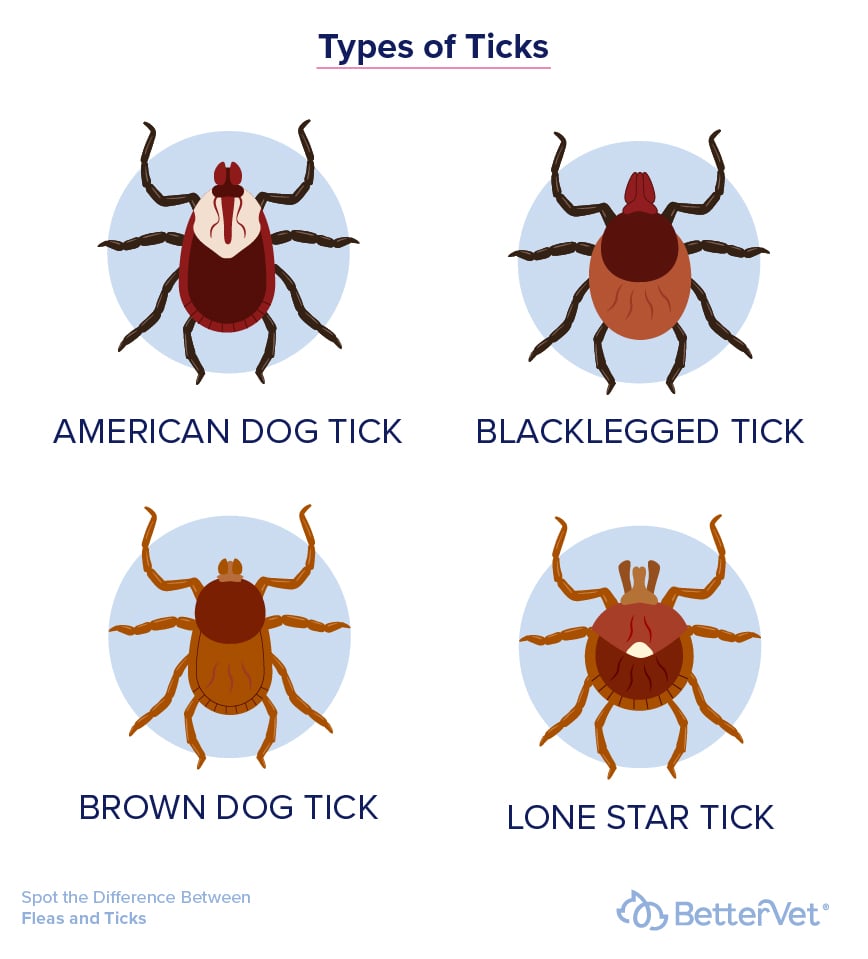How to Spot the Difference Between Fleas and Ticks

As a pet parent, spotting the difference between fleas and ticks can be tricky. How do you tell the difference between these two pesky critters? The answer is not always intuitive.
As vets, we understand the importance of pet parents staying informed on flea and tick bites and identifying the difference between the two.
This post will explore everything you need to know about symptoms, identification, and the prevention of fleas and ticks.
First, use our interactive map to determine your pet’s risk of flea and tick exposure where you live.

Fleas vs. Ticks: How Do You Tell the Difference?
Ever wondered what fleas and ticks look like? The answer is more complicated than you'd think! Visibly, ticks are much larger in size than fleas.
Fleas are only about 1/8th of an inch long, making them quite difficult to find with the naked eye. These small, wingless insects might appear as a simple speck of pepper. Often, fleas are only visible under a microscope.
Ticks are dark in color, with a flattened body, and they can be seen with the naked eye.

Symptoms and Warning Signs of Flea Bites
Flea bites on dogs and cats will leave tiny, raised dots. However, in certain dogs, it can be difficult to visibly see the flea bites under lots of fur. Instead, the tell-tale sign of flea bites is severe itchiness.
While every pet will respond differently to flea bites, some common symptoms and warning signs include:
- Itching and scratching
- Biting or chewing
- Hair loss, which can be secondary to biting
- Scabbing
- Red or irritated skin, sometimes from excessive itching
- Visible flea "droppings" or "dirt," which are dried blood specks around the infested area
Symptoms and Warning Signs of Tick Bites
The symptoms of tick bites are different from those of flea bites in dogs and cats. Tick bites may have a bullseye appearance and develop a scab or raised lesion.
Unlike flea bites, ticks are generally stationary and feeding. While many types of ticks are not harmful, some types of ticks can carry and transmit diseases to your dog or cat that can make them sick. There are several different kinds of ticks to watch out for, and your veterinarian can tell you which ones to look out for in your area.
Tick bites in pets often manifest in specific areas, such as in and around the ears, around the tail, or around the eyelids.
Some symptoms and warning signs of a harmful tick bite include:
- Wobbling and limping
- Weakness or decreased energy
- Loss of appetite, vomiting
- Swollen lymph nodes
- Shaking head or ears
- Low energy

Fleas vs. Ticks on Cats
When identifying fleas vs. ticks on cats, it's important to remember that fleas are far more common in cats. While ticks are more serious due to tick-borne illnesses, they are found less frequently on cats.
Cats that go outdoors are commonly exposed to fleas. However, even indoor cats can get exposed to these pesky parasites too.
While there are over 800 different species of ticks, only about a dozen types can cause illnesses in cats.
Seeking proper treatment for fleas and ticks on cats is important, as illness can progress without treatment. Untreated fleas or ticks may cause cardiac problems, kidney failure, or other concerning health issues.
Fleas vs. Ticks on Dogs
Determining the difference between fleas vs. ticks on dogs can be difficult. Both ticks and fleas feed off the blood of host animals, causing uncomfortable symptoms.
If your veterinarian suspects your dog may be at risk for a tick-borne illness, they might recommend various types of blood work. Pet blood work involves performing specific diagnostic tests designed to help confirm the diagnosis and help your vet develop an appropriate treatment plan.
Some examples of tick-borne diseases that affect dogs include Lyme disease and Rocky Mountain Spotted Fever. The best way to help protect your dog against these dangerous tick-borne diseases is through proper tick prevention.
Prevention of Fleas and Ticks
As a pet parent, you're likely to have wondered how to prevent fleas and ticks on your cat or dog. There are many approaches to flea and tick prevention, including flea prevention collars, topical preventatives, and oral preventative medications in a chewable treat form.
During your pet's next visit, your BetterVet veterinarian can help you to determine which flea and tick prevention method is best for your pet's unique situation. A regularly scheduled pet wellness exam is an important part of your pet's preventative care plan and long-term health and happiness.
Many pet parents also ask us how often they should be checking for fleas and ticks. It's important to do a visual check for fleas and ticks on your pet daily, especially during the warmer months.
Learn More About Fleas and Ticks
Get prepared for National Flea and Tick Prevention Month by learning more about preventing fleas and ticks on your pet. Have more questions about the difference between fleas and ticks or prevention? Book an appointment with your BetterVet veterinarian to discuss your pet's needs today. We offer online veterinary telemedicine consultations and home visits, delivering the best veterinary experience for pets and pet parents.
Frequently Asked Questions
Why does my indoor cat keep getting fleas?
One common way indoor cats get fleas is from other pets in the home. Indoor cats can also get fleas from humans who track fleas into the home onto their clothing or shoes. Fleas can also come into the home via rodents like mice or rats. While indoor cats are at a lower risk of getting fleas, there are still many ways an indoor cat can be exposed to fleas.
How long does it take to get rid of fleas and ticks on cats and dogs?
The length of time it will take to get rid of fleas or ticks on cats and dogs will depend on the type of treatment. Most oral and topical medications work within 24 to 48 hours. Fleas often die faster than ticks. Be sure to ask your vet how long to expect, depending on the treatment provided to your cat or dog. Often a minimum of several consecutive months of flea treatment is needed to eradicate fleas and environmental measures (laundering, vacuuming) must be implemented as well.
What kills ticks on cats instantly?
Topical treatments can kill ticks on cats instantly, as soon as direct contact is made with their fur or skin.






